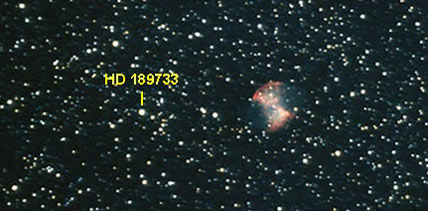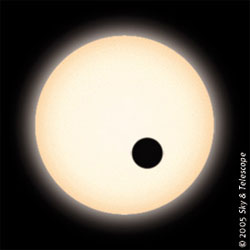
Just 0.3° due east of the familiar Dumbbell Nebula, M27 in Vulpecula, shines the 7.7-magnitude star HD 189733 with a very hot Jupiter in close orbit around it. Binoculars are all you need to see the star, a pale orange K dwarf 63 light-years away. The star is at right ascension 20h 00.7m, declination +22° 43' (2000.0 coordinates). This view is 0.9° wide; click on the image for a view 1.3° wide. North is up, east is left.
Photo by Akira Fujii.
The European planet-hunting team founded by Michel Mayor (Geneva Observatory, Switzerland) has just announced a new extrasolar planet that crosses the face of its host star — the ninth transiting exoplanet found to date. But this planet is special. The planet, which orbits the 7.7-magnitude type-K star HD 189733 in Vulpecula, offers professional astronomers their best prospects for studying an exoplanet's atmosphere and temperature. It also gives amateurs their easiest opportunity to detect a world orbiting another star. Moreover, the host star is located just 0.3° from the Dumbbell Nebula (M27), ideally positioned for Northern Hemisphere observers during early evening this season.
Using the 1.9-meter telescope at the Haute-Provence Observatory in France, Mayor's group used the radial-velocity method to discover the planet's gravitational tug on its host star. These observations not only revealed the planet, they also indicated that the planet periodically blocks some of the star's light. Follow-up observations with Haute-Provence's 1.2-meter telescope confirmed the transits (which last 2 hours) and the fact that the star's brightness drops by a whopping 3 percent (0.03 magnitude) every time the planet crosses the star's disk. These are the deepest exoplanet transits yet seen.

An artist depicts the newly discovered planet transiting its host star, HD 189733. The planet's diameter is about 17 percent of the star's, meaning it blocks about 3 percent of the star's light during transits.
S&T illustration by Gregg Dinderman.
The combined radial-velocity and transit observations have yielded the planet's mass (1.15 Jupiters), diameter (1.26 Jupiters), orbital period (2.219 days), distance from its host star (0.0313 Earth's distance from the Sun), and density (0.75 gram per cubic centimeter, confirming that it is a bloated gas giant). Lead author François Bouchy (Marseille Astrophysics Laboratory, France) and his colleagues report these findings in a paper submitted to Astronomy & Astrophysics.
Based on the host star's temperature and the 0.0313-astronomical-unit separation, the planet's temperature must be several hundred degrees Celsius. This places it in the class of "very hot Jupiters" — Jupiter-mass planets that orbit their host stars in less than 3 days. With its high temperature, it's almost inconceivable that any life exists on this planet or any moons it might have.
"This planet is absolutely phenomenal for follow-up observations," says David Charbonneau (Harvard-Smithsonian Center for Astrophysics), who has used the Hubble and Spitzer space telescopes to detect the atmospheres and measure the temperatures of several other transiting exoplanets. Charbonneau's Harvard colleague Scott Gaudi adds, "This planet is going to be a gold mine for learning about planets through follow-up observations."
Researchers are ecstatic about the HD 189733 planet (HD 189733b) for several reasons. First, its incredibly tight orbit means transits occur frequently. Second, the 3 percent brightness decrease (due to the planet's relatively large size with respect to the star) makes transits easy to detect. Third, the star is bright, being only 63 light-years from Earth, which means astronomers can achieve a high signal-to-noise ratio in their observations. Fourth, the planet's high temperature guarantees that Spitzer can detect its heat emission, as the telescope has previously done for the transiting exoplanets HD 209458b and TrES-1.
Thanks to these favorable conditions, research won't be limited to professional astronomers. The star itself is so bright that it can be seen with just a pair of binoculars. Amateur astronomers and students using small telescopes equipped with CCDs will easily be able to measure the 3 percent drop in brightness caused by the transits. "Heck, this transit is so deep some of our most experienced visual observers could do it!" claims Aaron Price of the American Association of Variable Star Observers.

The little constellation Sagitta, the Arrow, is the key to finding the Dumbbell Nebula, M27 (which glows at 8th magnitude) and its exoplanet-host neighbor star. Sagitta is located 10° north of bright Altair. M27 (at the top left corner here) is located 3.3° north of the point of the Arrow. An old observer's trick: imagine the arrow pivoting counterclockwise around its point through a third of a circle. The Arrow's middle star would then lie right on M27.
Sky & Telescope diagram.
Gregory P. Laughlin (University of California, Santa Cruz), a cofounder of Transitsearch.org, has added HD 189733 to his observing list. Transitsearch.org organizes worldwide amateur observing campaigns to catch transiting exoplanets. The next transit occurs at 1:53 UT, October 8th, which is best suited for eastern North America observers. By tracking any slight irregularities in the timing of future transits, professionals and amateurs could detect the gravitational presence of additional planets in the system, including planets with masses as low as Earth's.
"It will be very interesting to get high-quality amateur photometry for additional radius estimates, since like HD 209458b, the HD 189733 planet is clearly larger than predicted by standard models," says Laughlin. "Since high-end amateur setups are reliably observing the HD 149026b transit, whose depth is close to 10 times shallower than the HD 189733 transit, I think we can expect to see some awesome light curves of the transit." Laughlin also notes that amateur observations will reveal whether the star is marred by starspots.
More information about the planet and the discovery team can be found in the Haute-Provence press release.
 0
0
Comments
You must be logged in to post a comment.